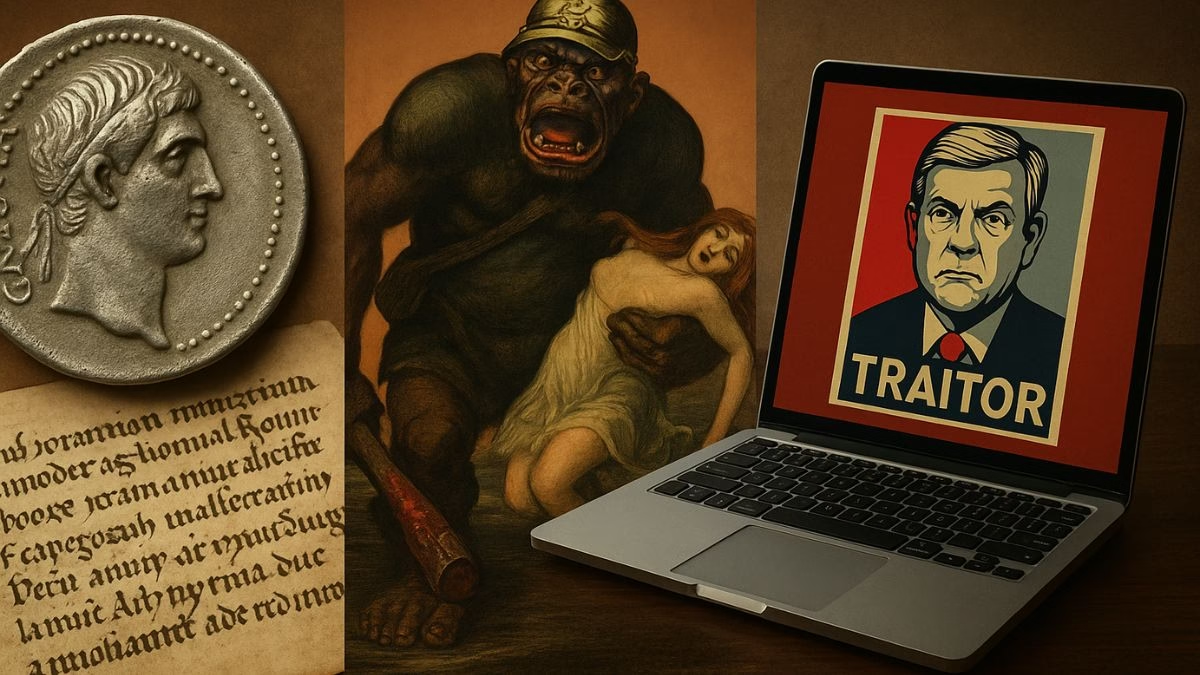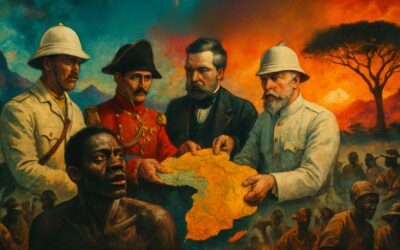- Audio Article
- The Uncanny Echo in the Machine
- The Original Political Meme: Propaganda in Ancient Rome
- The Reformation: When a New Technology Fomented a Schism
- The World at War: Perfecting the Art of “The Other”
- History as a Weapon of Resistance
- MagTalk Discussion
- Focus on Language
- Vocabulary Quiz
- Let’s Discuss
- Learn with AI
- Let’s Play & Learn
Audio Article
The Uncanny Echo in the Machine
We are, by all accounts, living in a state of information overload, perpetually adrift in a digital ocean churning with falsehoods. We blame the algorithms, the bots, the deepfakes, the sheer unprecedented speed and scale of the internet. It feels so dizzyingly new, so uniquely a product of our modern technological moment, that we often assume the problem itself is new. We believe we are the first generation to face the challenge of a society-wide crisis of truth. We are not.
If we mute the digital noise for a moment and listen closely, we can hear the uncanny echoes of the past. The techniques of the modern disinformation agent—the emotional manipulation, the scapegoating, the character assassination, the creation of a menacing “other”—are not a revolutionary playbook written in code. They are a perennial human playbook, refined over millennia, that has been handed down from Roman emperors to religious reformers to wartime propagandists. The technology has changed, evolving from chiseled stone to the printing press to the smartphone, but the target has remained the same: the flawed, biased, and easily exploitable architecture of the human mind.
This article is a journey back in time to arm ourselves for the present. By taking a historian’s view, we will discover that while the tools are new, the tricks are ancient. We will draw a direct line from the character assassination minted on Roman coins to the attack ads that flood our social media feeds. We will see the viral spread of Reformation pamphlets in the echo chambers of today. We will recognize the stark, demonizing caricatures of wartime posters in the political memes that divide us. By understanding that we are not the first to face these tactics, we can learn from those who have faced them before. History, it turns out, is one of our most powerful tools for building resistance to manipulation today.
The Original Political Meme: Propaganda in Ancient Rome
Long before the internet, long before even the concept of mass media, rulers understood the power of a simple, repeatable message. Our first stop is the Roman Republic, a cutthroat political environment where a well-placed rumor could be as effective as a well-placed dagger. Here, propaganda was a state-of-the-art, multimedia campaign.
Character Assassination, Minted in Silver
Imagine a Roman citizen in 32 B.C. They don’t have a television or a smartphone, but they have a pocketful of coins. The most powerful man in Rome, Octavian (the future emperor Augustus), is locked in a bitter power struggle with his rival, Mark Antony, who has famously allied himself with the Egyptian queen, Cleopatra. How does Octavian turn the Roman people against a celebrated general? He launches one of the most successful smear campaigns in history, using the most ubiquitous form of media available: the denarius.
Octavian’s mints begin churning out coins that are, in essence, the first political attack ads. One side might bear his own handsome, traditionally Roman visage. The other side, instead of a goddess or a symbol of Roman strength, depicts Antony in a new light. His features are made to look decadent, vaguely foreign. The inscriptions link him not to Roman virtues but to Cleopatra, casting him as a man who has “gone native”—a Roman seduced and controlled by an Eastern queen, a drunkard who has abandoned his heritage. Antony’s own coins, showing him and Cleopatra as a divine couple, were easily reframed by Octavian as proof of his rival’s blasphemy and un-Roman ambitions.
This was a deft and insidious strategy. Every time a citizen bought bread, paid a tax, or gambled in a tavern, they were handling a piece of Octavian’s propaganda. The message was simple, visceral, and repeated millions of times over: Octavian is the true Roman, the defender of tradition. Antony is the corrupted traitor, the puppet of a foreign seductress. It was a classic “us vs. them” narrative, stamped in silver and distributed to every corner of the Republic. It didn’t matter if it was true. It was effective. Octavian won the information war, and shortly after, the civil war that made him emperor.
The Echo in the Algorithm
The tools have changed, but has the tactic? A modern political campaign that creates a flood of memes showing their opponent in an unflattering light, perhaps subtly altering their appearance to look weaker or more sinister, is running the exact same play. They are bypassing complex policy debates in favor of a rudimentary, emotional appeal. They are creating a simple, repeatable visual message designed to assassinate a rival’s character. The Roman denarius was a slow-moving but powerful piece of viral media. A digital meme is the same concept, supercharged by algorithms. The psychological button being pushed is identical.
The Reformation: When a New Technology Fomented a Schism
If Rome teaches us about character assassination, the Protestant Reformation of the 16th century teaches us about the explosive power of a new communication technology. The internet of its day was Johannes Gutenberg’s printing press, and it turned a theological dispute into a full-blown information war that tore Europe apart.
Pamphlets, Woodcuts, and Going Viral
Before the printing press, the Catholic Church held a near-monopoly on the dissemination of information. Books were rare, expensive, and controlled by the clerical elite. Martin Luther, a German monk with a list of 95 grievances against the Church, would have likely ended up as a forgotten heretic if not for this new technology.
When Luther nailed his Ninety-five Theses to the church door in Wittenberg in 1517, he was engaging in a traditional academic debate. But his allies saw the potential of the press. The Theses were quickly translated from scholarly Latin into common German and printed as cheap pamphlets. Suddenly, a debate among theologians became a public firestorm. Luther and his supporters became masters of this new medium. They churned out thousands of pamphlets, written in punchy, accessible language that the common person could understand.
The propaganda became increasingly visceral. To counter the Church’s authority, they had to vilify it. Woodcut illustrations—the memes of the 16th century—became a key weapon. These cartoons depicted the Pope as the Antichrist, a monstrous figure being fed money by the desperate poor, or as a fat demon in the jaws of hell. This was not theological debate; it was raw, emotional propaganda designed to create disgust and outrage. The Church, slow to adapt to the new technology, tried to respond with its own pamphlets, but it was too late. Luther’s message had already gone viral, creating a passionate and mobilized public that shattered the religious unity of Europe.
The Filter Bubbles of the 16th Century
The Reformation shows us a pattern that is eerily familiar. A new technology democratizes the creation and spread of information, breaking the monopoly of traditional gatekeepers (the Church then, mainstream media now). This creates an opening for a new, powerful narrative to emerge that directly challenges the establishment. The most successful messages are not the most nuanced, but the most emotionally resonant, often relying on a stark “us vs. them” framing.
People in a German town who were eagerly consuming Luther’s pamphlets were in their own kind of filter bubble, their beliefs reinforced by a steady stream of content that confirmed their worldview and demonized the other side. The schism that resulted was not just about theology; it was about two groups of people living in increasingly different information realities. That is a story that should sound deeply, and uncomfortably, familiar to any observer of our modern world.
The World at War: Perfecting the Art of “The Other”
Our final stop is the 20th century, where the technologies of mass media—lithography, radio, cinema—were harnessed by nation-states to mobilize their populations for total war. It is here that propaganda was refined into a brutal and efficient science, built on one archetypal foundation: the creation of a monstrous and inhuman enemy.
The Archetypal Enemy on the Poster
Walk through an exhibit of propaganda posters from World War I or II, and the patterns become chillingly clear. Regardless of the nation that produced them, the techniques are the same. The enemy is never depicted as a complex human being, a soldier who is likely just as scared as the soldiers on your own side. Instead, he is an archetype of evil.
American posters depicted the German soldier as a grotesque, drooling ape-like “Hun,” often carrying a terrified, half-naked white woman. This wasn’t just an insult; it was a deliberate act of dehumanization. An ape is not a person; you don’t have to feel remorse for killing an ape. It transformed the war from a political conflict into a fight to save civilization from barbarism.
Nazi propaganda, with even more horrific consequences, perfected this art. Posters and films depicted Jewish people as spiders, rats, or vampires—parasitic vermin that were infesting the pure German nation. By relentlessly portraying an entire group of people as subhuman, the regime made the unthinkable—their systematic extermination—seem not just possible, but necessary. A pest control problem.
These posters all rely on the same core tactics. They use powerful, emotionally charged symbols. They appeal to our deepest fears—fear of racial defilement, fear of national destruction. They create a simple, binary choice: we are the heroes, they are the monsters. There is no middle ground, no room for empathy.
Dehumanization in 280 Characters
Today, the poster has been replaced by the social media post, but the dehumanizing instinct is alive and well. When we see online rhetoric that describes political opponents not as fellow citizens with different ideas, but as “traitors,” “vermin,” or an infection that must be “cleansed,” we are seeing the direct ideological descendant of the wartime propaganda poster.
This language is designed to do the same work: to strip our opponents of their humanity, making it easier to hate and dismiss them. It short-circuits our capacity for empathy and makes political disagreement feel like an existential battle. It is the final, ugly endpoint of the “us vs. them” narrative that we saw stamped on Roman coins and printed in Reformation pamphlets. It is the language of total war, deployed in a time of supposed peace.
History as a Weapon of Resistance
The digital tools at the disposal of a modern propagandist would be the envy of any Roman emperor or Reformation pamphleteer. The ability to micro-target an audience, to A/B test messages in real time, and to achieve global reach in an instant is a terrifying new development. But the power of these tools still relies on their ability to activate the ancient, pre-programmed vulnerabilities in our own minds.
This is where history offers us a sliver of hope. It provides us with a bestiary of these manipulative tactics in their original forms. When we have seen the face of the scapegoating ape on a World War I poster, we are better equipped to recognize the same dehumanizing language in a tweet. When we understand the “us vs. them” narrative on a Roman coin, we become more skeptical of a political ad that uses the same crude dichotomy.
To study the history of propaganda is to develop a kind of immunity. It allows us to step back from the frantic, emotionally charged present and see the timeless patterns at play. It teaches us that we are being subjected to a very old and very human set of tricks. History shows us the propagandist’s playbook. Once you’ve read it, you’re much harder to fool.
MagTalk Discussion
Focus on Language
Vocabulary and Speaking
Let’s pull out our magnifying glasses and examine some of the words and phrases that gave the article its historical flavor and analytical punch. When you’re trying to connect the past to the present, your vocabulary needs to act as a bridge, using words that are timeless enough to describe a Roman emperor and a modern-day internet troll. These are words you can absolutely use to make your own arguments more vivid and intelligent.
Let’s kick things off with uncanny. In the introduction, I mentioned the “uncanny echoes of the past.” Something that is uncanny is strange or mysterious, especially in an unsettling way. It’s not just “weird”; it has a specific flavor of being weirdly familiar, like you’ve seen or experienced it before in a different context. Déjà vu can feel uncanny. A robot that looks almost, but not quite, human is described as being in the “uncanny valley.”6 When we say the echoes of ancient propaganda are uncanny, we mean it’s unsettling how similar they are to what we see today. It’s a great word to use when something is strangely familiar. “There was an uncanny resemblance between the two strangers.” Or, “She had an uncanny ability to predict what I was going to say next.”
Next, let’s look at the word perennial. We called the propagandist’s playbook a “perennial human playbook.” A perennial plant is one that lives for many years, coming back again and again.7 So, when we use this word as an adjective, it means lasting or existing for a long, seemingly infinite time; enduring or continually recurring. It’s not just old; it’s something that is always present, always relevant. Arguing with your parents about your curfew might be a perennial struggle for teenagers. The debate over taxes is a perennial issue in politics. It’s a fantastic word for describing problems, themes, or struggles that are a constant feature of the human experience. “Finding a good work-life balance is a perennial challenge for many people.”
Let’s grab a word straight from the propagandist’s toolkit: vilify. We talked about how Reformation woodcuts were used to vilify the Pope. To vilify someone is to speak or write about them in an abusively disparaging manner. It’s to turn them into a villain. It’s not just criticizing; it’s a deliberate act of character assassination designed to make someone seem evil. Political campaigns often try to vilify their opponents, painting them as corrupt or dangerous.8 “The press began to vilify the actor after his controversial statements.” It’s a strong, active verb that perfectly captures the malicious intent of turning a person or group into the bad guy.
Now for a word that describes what propaganda often tries to create: a schism. We said the printing press “fomented a schism.” A schism is a split or division between strongly opposed sections or parties, caused by differences in opinion or belief. The word is most often used to talk about a split in a religious organization, like the Great Schism between the Eastern Orthodox and Roman Catholic churches. But you can use it to describe any deep, formal split. The Protestant Reformation was the ultimate schism in Western Christianity.9 You could use it metaphorically to describe other divisions: “The disagreement over the company’s future direction led to a schism on the board of directors.” Or, “The political party is facing a potential schism between its moderate and progressive wings.”
Let’s talk about a word that describes the type of appeal propaganda makes: visceral. I mentioned that the messages on Roman coins were visceral. The viscera are your internal organs—your gut. So, a visceral reaction is one that comes from deep inward feelings rather than from intellect. It’s a gut feeling. It’s instinctual, emotional, and not based on logical thought. A great horror movie produces a visceral fear. The taste of a food you loved as a child can trigger a visceral sense of nostalgia. Propaganda almost always aims for a visceral reaction. It wants to bypass your rational brain and hit you right in the gut with fear, anger, or tribal loyalty. “The images from the war zone provoked a visceral response from viewers.”
Here’s a great adjective for describing a skillful manipulator: deft. Octavian’s propaganda campaign was described as a “deft and insidious strategy.” Deft means neatly skillful and quick in one’s movements or actions.10 A deft surgeon has steady, precise hands. A deft politician can navigate a tricky conversation with ease. It implies a kind of elegant, intelligent skill. Calling a propaganda campaign deft is a way of acknowledging its cleverness and effectiveness, even while you’re condemning its malicious purpose. “She gave a deft response to the reporter’s difficult question.” Or, “With a few deft strokes of the pen, the artist captured her likeness.”
Let’s look at the word archetypal. We said the wartime enemy is an archetypal figure of evil. An archetype is a very typical example of a certain person or thing; a recurrent symbol or motif in literature, art, or mythology.11 For example, the hero, the mentor, the trickster, and the villain are all archetypes. So, something that is archetypal is a perfect, classic example of one of these fundamental patterns. The way propaganda portrays the enemy is archetypal—it’s not a specific, nuanced person, but the pure essence of “The Villain.” “The story’s hero is an archetypal figure: the reluctant farm boy who discovers he has a great destiny.” You can use it to describe anything that seems to be a perfect model of a common type.
Next, a fantastic verb: foment. This appeared alongside schism: “to foment a schism.” To foment something (usually something bad, like trouble or rebellion) is to instigate or stir it up. It’s like adding fuel to a fire to make it bigger. It’s a deliberate act of provocation. A political agitator might try to foment unrest among the population. “The foreign government was accused of trying to foment a revolution in the neighboring country.” It’s a more formal and powerful word than “incite” or “provoke.” It suggests a more sustained and deliberate effort of stirring up trouble.
Let’s talk about the word rudimentary. We said that a political meme is a “rudimentary, emotional appeal.” Rudimentary means involving or limited to basic principles. It’s simple, basic, and not very developed. A rudimentary knowledge of a language means you know a few basic phrases but not much else. A rudimentary tool is a very simple one, like a sharpened stone. When we describe propaganda as rudimentary, we’re pointing out that it’s not trying to make a sophisticated, complex argument. It’s deliberately simple and basic to appeal to our most primitive emotions. “He only has a rudimentary understanding of how a computer works.”
Finally, let’s revisit the word playbook. We used it throughout the article to refer to the “propagandist’s playbook.” In sports, a playbook is literally a book containing a team’s strategies and plays. We use it metaphorically to refer to a stock of pre-arranged tactics or strategies. It’s a set of moves you can use to handle a particular situation. When we say that propagandists are all using the same playbook, we mean they are all using the same set of time-tested techniques. “When the company got into a crisis, the PR team followed their standard playbook: issue a vague apology and promise to do better.” It’s a great piece of modern slang for a pre-planned set of tactics.
Using these words will add a layer of historical depth and analytical precision to your own conversations.
Now for our speaking skill. A key part of the article was making history feel relevant and alive. The skill I want you to practice is drawing parallels with historical analogies. When you’re trying to explain a complex modern situation, anchoring it in a well-known historical event can make it instantly clearer and more compelling. It shows that you’re not just reacting to the current moment, but that you see the deeper patterns at play.
Here’s your challenge: The next time you are in a discussion about a current event—a political conflict, a new technology, a social movement—I want you to try to connect it to a historical event, even a small one. You don’t have to be a history professor. Just make a simple, clear connection. For example, if people are talking about the rapid spread of a viral rumor on social media, you could say, “You know, this reminds me of how Martin Luther used the printing press. It’s the same dynamic: a new technology allows a revolutionary idea to bypass the old gatekeepers and spread like wildfire.” Or if you’re discussing a heated political rivalry, “It has the same kind of ‘us vs. them’ feel as the campaign between Octavian and Mark Antony.” Your mission is to find one opportunity to use a historical analogy to frame a modern problem. It will make you sound incredibly insightful and will elevate the conversation by adding a layer of much-needed context.
Grammar and Writing
Let’s shift our focus from the history of propaganda to the practice of analyzing it. The ability to dissect a piece of modern media and identify the ancient techniques at play is a crucial skill. It’s a form of critical thinking that requires you to be both an observer of the present and a student of the past.
Here is your writing challenge:
Find a modern example of what you consider to be propaganda or a piece of disinformation. This could be a political TV ad, a viral meme, a social media post, an online article, or a poster. Your task is to write a short analytical essay (500-700 words) that deconstructs this piece of media. Your essay should: 1) Briefly describe the piece of media you’ve chosen. 2) Identify at least two of the ancient persuasive techniques discussed in the article (e.g., scapegoating, emotional appeal, “us vs. them,” character assassination, dehumanization). 3) Use a historical parallel from the article (Roman, Reformation, or World Wars) to show how the modern technique echoes the past.
This is an exercise in comparative analysis. You are building an argument by connecting two seemingly different things—a modern meme and a Roman coin, for example—to reveal a deeper truth. To write a compelling analysis, let’s focus on two essential writing tools: using specific phrases for comparison and integrating evidence through quotation and description.
First, let’s master the language of comparison. Your entire essay is built on drawing parallels. You need a toolkit of transitional words and phrases that signal to your reader that you are making a connection between the past and the present. Avoid just saying “This is like that.” Use more sophisticated language to show the relationship.
Here are some phrases you can use:
To introduce a direct parallel: “Just as…” / “In the same way that…” / “This mirrors the technique of…”
Example: “Just as Octavian used his coins to cast Mark Antony as a foreign-influenced traitor, this political ad uses imagery of the opponent’s foreign travel to subtly question their loyalty.”
To show a similar pattern or echo: “This is a modern iteration of…” / “We can see an echo of this in…” / “In a similar vein…”
Example: “We can see an echo of the Reformation’s crude woodcuts in the simplistic, often grotesque caricatures used in this political meme.”
To connect to the core principle: “This taps into the same psychological vulnerability that…” / “The underlying playbook is identical to…”
Example: “The underlying playbook is identical to that of wartime propagandists: create a dehumanized, archetypal enemy to justify aggression.”
By using these phrases, you move from simple observation to sophisticated analysis. You are explicitly guiding your reader to see the historical connection that you are making.
Second, your analysis is only as strong as your evidence. You need to show your reader what you’re talking about by integrating specific details from both your modern and historical examples. You can do this through direct quotation (if there’s text) or vivid description (if it’s an image).
Let’s say you’re analyzing a modern political poster that shows an immigrant as a shadowy, threatening figure.
Weak Evidence: “The poster makes immigrants look bad, like the old war posters did.” (This is too vague.)
Strong Evidence: “The poster depicts the immigrant not as a person, but as a faceless, hooded silhouette, a technique of dehumanization that is a direct descendant of the World War I posters that portrayed German soldiers as monstrous, ape-like ‘Huns.’ In both cases, the goal is to strip the ‘other’ of their individuality and humanity, making them easier to fear. The poster’s caption, ‘They are not like us,’ further reinforces this “us vs. them” narrative, which mirrors the very same dichotomy Octavian crafted to separate the ‘true Roman’ from the ‘corrupted’ Mark Antony.”
Notice how the strong example works. It uses specific descriptive language (“faceless, hooded silhouette”), directly quotes the caption (“They are not like us”), and then uses the comparative phrases we just discussed (“direct descendant of,” “mirrors the very same dichotomy”) to link these specific details back to the historical examples. This creates a tight, evidence-based argument.
So, as you tackle your writing challenge, follow this process:
Choose your modern example and study it closely. What specific words, images, and symbols are being used?
Identify the core techniques at play. Is it creating an “us vs. them”? Is it a visceral emotional appeal?
Structure your argument using comparative language. Use phrases like “Just as…” and “This mirrors…” to build the bridge between past and present.
Support every point with specific, concrete evidence from both your modern and historical examples. Describe the images. Quote the text.
By following these steps, you can write a powerful essay that doesn’t just state an opinion but proves a thesis: the more things change, the more they stay the same.
Vocabulary Quiz
Let’s Discuss
Here are some questions to get you thinking more deeply about the history of propaganda and its modern implications. Share your thoughts and ideas in the comments.
The article argues that the techniques of propaganda are ancient, but the tools are new. What, in your opinion, is the single most significant difference that modern technology (the internet, AI) makes? Does the speed and scale change the nature of the problem itself?
Think about the difference between a Roman coin, which took weeks to circulate, and a viral tweet, which can reach millions in minutes. Consider the impact of algorithms creating personalized propaganda feeds. Does the fact that anyone can now be a propagandist, not just emperors or states, fundamentally alter the dynamic?
Can propaganda ever be used for good? Think of public health campaigns (e.g., against smoking) or wartime posters designed to boost morale and national unity. Where do we draw the line between “good” persuasion and “bad” manipulation?
Is the key difference the goal (public health vs. political gain)? Is it the technique (using positive emotions vs. fear and hatred)? Is it about truthfulness? Discuss whether “noble lies” are ever justified and who gets to decide what constitutes a “good” cause.
The article focuses on political and military propaganda. Where do you see these same ancient techniques being used in other areas of modern life, such as commercial advertising or social media influencer culture?
Think about how ads create an “us” (the cool, attractive people who use our product) and a “them” (those who don’t). Consider how influencers use emotional appeals and create a sense of authenticity to persuade their followers. Are the lines between political propaganda, commercial advertising, and personal branding blurring?
The article suggests that knowing history can make us more resilient to manipulation. Do you agree? What are some other skills or literacies people need to develop to navigate the modern information environment?
Besides historical literacy, what about data literacy (understanding statistics), media literacy (understanding how media is made and funded), or emotional intelligence (recognizing when your own emotions are being targeted)? Which do you think is most important?
If you could go back in time and show one historical figure (like Octavian, Martin Luther, or a WWI propagandist) one modern piece of disinformation, who would it be and what would you show them? What do you think their reaction would be?
This is a creative thought experiment. Would Octavian be impressed by the efficiency of a Twitter botnet? Would Martin Luther be shocked by the sheer volume and chaos of the online religious debate? What might they recognize, and what would be completely alien to them? What could they, in turn, teach us?
Learn with AI
Disclaimer:
Because we believe in the importance of using AI and all other technological advances in our learning journey, we have decided to add a section called Learn with AI to add yet another perspective to our learning and see if we can learn a thing or two from AI. We mainly use Open AI, but sometimes we try other models as well. We asked AI to read what we said so far about this topic and tell us, as an expert, about other things or perspectives we might have missed and this is what we got in response.
Hello. It’s a fascinating and vital historical perspective. The article does a brilliant job of demonstrating the timelessness of the psychological appeals used by propagandists. It correctly argues that the why and the what of manipulation haven’t changed much. As a historian who specializes in the evolution of communication technology, I’d like to build on that by focusing on something the article touched on but that deserves more emphasis: how modern technology has fundamentally revolutionized the how, and why that creates a danger that is, in fact, historically unprecedented.
The key difference can be summed up in two words: speed and feedback.
Let’s talk about speed first. Yes, a Roman coin was a brilliant piece of propaganda, but its velocity was limited to the speed of a horse or a ship. It took months, even years, for its message to fully permeate the empire. This created a natural time lag. A rumor had time to be questioned, a counter-message had time to be formulated and distributed. The information environment was, by its very nature, low-frequency. The modern digital environment is the opposite. A lie can be manufactured in Moscow, London, or Beijing and be on a smartphone in Ohio or Lebanon in less than a second. It can reach millions before any institutional fact-checker is even aware of its existence. This isn’t just a quantitative change; it’s a qualitative one. It eliminates the crucial human processing time that used to act as a buffer for critical thought. The sheer velocity of modern disinformation is a weapon in itself, designed to overwhelm our capacity to reason.
The second, and perhaps more transformative, difference is the feedback loop. Think about Octavian. He minted his coins and sent them out into the world. Did he know for sure which messages were the most effective? Not really. He had to rely on slow, anecdotal reports from governors and spies. He was broadcasting his message into a void and hoping for the best.
Now, consider a modern disinformation campaign. They don’t just broadcast; they interact. They can release ten slightly different versions of a meme or an ad and, within hours, their analytics will tell them exactly which one is getting the most shares, the most angry comments, the most emotional engagement. They can see, in real-time, which words, colors, and images are most effective at triggering their target audience. This allows them to constantly refine and optimize their propaganda on the fly. It’s no longer a monologue; it’s a conversation. They are A/B testing their way to the perfect lie.
This creates a dynamic of hyper-personalized, continuously-improving propaganda that no historical figure could have ever dreamed of. It’s the difference between a musket and a guided missile. Both are weapons, but one is a far more precise and devastating instrument. So while it’s absolutely true and empowering to know that the psychological buttons being pushed are ancient, it’s also crucial to recognize that the machine pushing those buttons is something entirely new. It’s faster, smarter, and it’s learning from our reactions every second. That’s the part of this battle that is truly, uniquely modern.










0 Comments